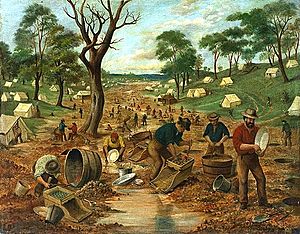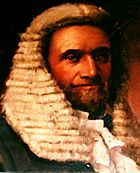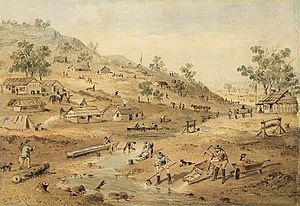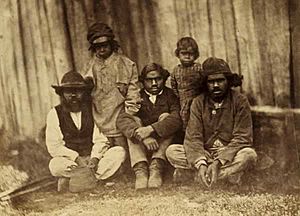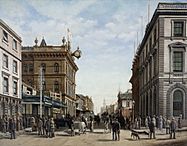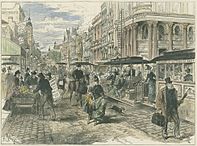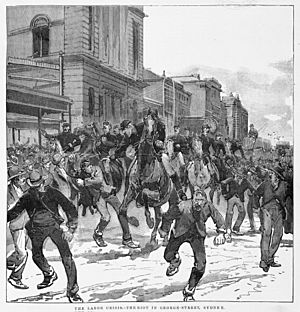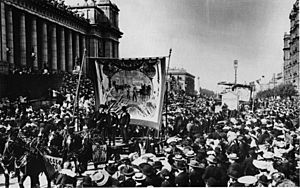History of Australia (1851–1900) facts for kids
The History of Australia (1851–1900) refers to the history of the indigenous and colonial peoples of the Australian continent during the 50-year period which preceded the foundation of the Commonwealth of Australia in 1901.
Contents
Gold rushes
The discovery of gold, beginning in 1851 first at Bathurst in New South Wales and then in the newly formed colony of Victoria, transformed Australia economically, politically and demographically. The gold rushes occurred hard on the heels of a major worldwide economic depression. As a result, about two per cent of the population of Britain and Ireland immigrated to NSW and Victoria during the 1850s. There were also large numbers of continental Europeans, North Americans and Chinese.
The rushes began in 1851 with the announcement of the discovery of payable gold near Bathurst by Edward Hargraves. In that year New South Wales had about 200,000 people, a third of them within a day's ride of Sydney, the rest scattered along the coast and through the pastoral districts, from the Port Phillip District in the south to Moreton Bay in the north. In 1836 a new colony of South Australia had been established, and its territory separated from New South Wales. The gold rushes of the 1850s brought a huge influx of settlers, although initially the majority of them went to the richest gold fields at Ballarat and Bendigo, in the Port Phillip District, which in 1851 was separated to become the colony of Victoria.
Victoria soon had a larger population than New South Wales, and its upstart capital, Melbourne, outgrew Sydney. But the New South Wales gold fields also attracted a flood of prospectors, and by 1857 the colony had more than 300,000 people. Inland towns like Bathurst, Goulburn, Orange and Young flourished. Gold brought great wealth but also new social tensions. Multiethnic migrants came to New South Wales in large numbers for the first time. Young became the site of an infamous anti-Chinese miner riot in 1861 and the official Riot Act was read to the miners on 14 July—the only official reading in the history of New South Wales. Despite some tension, the influx of migrants also brought fresh ideas from Europe and North America to New South Wales—Norwegians introduced skiing in Australia to the hills above the Snowy Mountains gold rush town of Kiandra around 1861. A famous Australian son was also born to a Norwegian miner in 1867, when the bush balladeer Henry Lawson was born at the Grenfell goldfields.
In 1858 a new gold rush began in the far north, which led in 1859 to the separation of Queensland as a new colony. New South Wales thus attained its present borders, although what is now the Northern Territory remained part of the colony until 1863, when it was handed over to South Australia. The separation and rapid growth of Victoria and Queensland mark the real beginning of New South Wales as a political and economic entity distinct from the other Australian colonies. Rivalry between New South Wales and Victoria was intense throughout the second half of the 19th century, and the two colonies developed in different directions. Once the easy gold ran out by about 1860, Victoria absorbed the surplus labour force from the gold fields in manufacturing, protected by high tariff walls. Victoria became the Australian stronghold of protectionism, liberalism and radicalism. New South Wales, which was less radically affected demographically by the gold rushes, remained more conservative, still dominated politically by the squatter class and its allies in the Sydney business community. New South Wales, as a trading and exporting colony, remained wedded to free trade.
Gold produced sudden wealth for a few, and some of Australia's oldest wealthy families date their fortunes from this period, but also employment and modest prosperity for many more. Within a few years these new settlers outnumbered the convicts and ex-convicts, and they began to demand trial by jury, representative government, a free press and the other symbols of liberty and democracy. Contrary to popular myth, there was little opposition to these demands from the colonial governors or the Colonial Office in London, although there was some from the squatters. New South Wales had already had a partly elected Legislative Council since 1825.
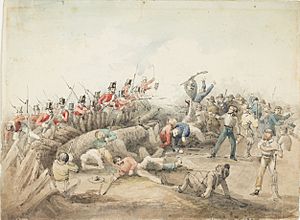
The Eureka Stockade of 1854, an armed protest by miners on the Victorian goldfields, and the debate that followed, served as a significant impetus for democratising reforms. The rebellion came about as a result of opposition to government mining licences. Licence fees had to be paid regardless of whether a digger's claim resulted in any gold and less successful operators found it difficult to pay their licence fees. Official corruption was another concern. In November 1854, thousands of diggers rallied to call for the abolition of the licence fee and the vote for all males. A Reform League was formed, with some of its leaders linked to the Chartist movement in England. On 30 November, a mass burning of licenses took place and protesters marched to the Eureka Diggings and constructed a stockade. Led by Peter Lalor, 500 men swore an oath under a flag featuring the Southern Cross and prepared to defend the stockade. On 3 December, the colonial troops attacked the stockade and a twenty-minute battle ensued in which 22 diggers and 5 soldiers were killed. Thirteen diggers committed for trial were all acquitted and the following year the government granted the demands of the rebels. In the subsequent 1855 elections, Peter Lalor became the first Member of the Legislative Council for the seat of Ballarat.
In 1855 New South Wales, Victoria, South Australia and Tasmania (as Van Diemen's Land was renamed) were granted full responsible government, with bicameral parliaments in which the lower houses were fully elected. The upper houses (Legislative Councils) remained dominated by government appointees and representatives of the squatters, worried that the radical democrats might try to seize their vast sheep-runs. Their fears were partly justified, with the Selection Acts of the 1860s, in particular the Robertson Land Acts of 1861, beginning the slow breakup of the squattocracy in Australia's more settled areas.
The arrival of Old World diseases were a catastrophe for the Aboriginal Australians. Between first European contact and the early years of the 20th century, the Aboriginal population dropped from an estimated 500,000 to about one tenth of that number (50,000). Smallpox, measles and influenza were major killers, many others added their toll; for a people without the thousands of years of genetically evolved resistance to diseases that Europeans had, even chickenpox was deadly.
The Bushrangers

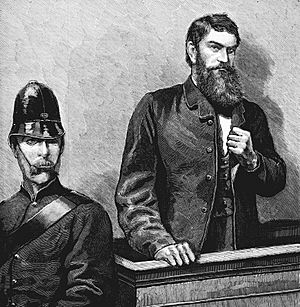
Bushrangers, originally referred to runaway convicts in the early years of the British settlement of Australia who had the survival skills necessary to use the Australian bush as a refuge to hide from the authorities. The term "bushranger" then evolved to refer to those who abandoned social rights and privileges to take up "robbery under arms" as a way of life, using the bush as their base. These bushrangers were roughly analogous to British "highwaymen" and American "Old West outlaws," and their crimes often included robbing small-town banks or coach services.
More than 3,000 bushrangers are believed to have roamed the Australian countryside, beginning with the convict bolters and drawing to a close after Ned Kelly's last stand at Glenrowan.
Bold Jack Donahue is recorded as the last convict bushranger. He was reported in newspapers around 1827 as being responsible for an outbreak of bushranging on the road between Sydney and Windsor. Throughout the 1830s he was regarded as the most notorious bushranger in the colony. Leading a band of escaped convicts, Donahue became central to Australian folklore as the Wild Colonial Boy.
Bushranging was common on the mainland, but Van Diemen's Land (Tasmania) produced the most violent and serious outbreaks of convict bushrangers. Hundreds of convicts were at large in the bush, farms were abandoned and martial law was proclaimed. Indigenous outlaw Musquito defied colonial law and led attacks on settlers
The bushrangers' heyday was the Gold Rush years of the 1850s and 1860s.
There was much bushranging activity in the Lachlan Valley, around Forbes, Yass and Cowra in News South Wales. Frank Gardiner, John Gilbert and Ben Hall led the most notorious gangs of the period. Other active bushrangers included Dan Morgan, based in the Murray River, and Captain Thunderbolt, killed outside Uralla.
The increasing push of settlement, increased police efficiency, improvements in rail transport and communications technology, such as telegraphy, made it increasingly difficult for bushrangers to evade capture.
Among the last bushrangers was the Kelly Gang led by Ned Kelly, who were captured at Glenrowan in 1880, two years after they were outlawed. Kelly was born in Victoria to an Irish convict father, and as a young man he clashed with the Victoria Police. Following an incident at his home in 1878, police parties searched for him in the bush. After he killed three policemen, the colony proclaimed Kelly and his gang wanted outlaws.
A final violent confrontation with police took place at Glenrowan on 28 June 1880. Kelly, dressed in home-made plate metal armour and helmet, was captured and sent to jail. He was hanged for murder at Old Melbourne Gaol in November 1880. His daring and notoriety made him an iconic figure in Australian history, folklore, literature, art and film.
Some bushrangers, most notably Ned Kelly in his Jerilderie Letter, and in his final raid on Glenrowan, explicitly represented themselves as political rebels. Attitudes to Kelly, by far the most well-known bushranger, exemplify the ambivalent views of Aussie regarding bushrangers.
Exploration of the interior

European explorers made their last great, often arduous and sometimes tragic expeditions into the interior of Australia over the period—some with the official sponsorship of the colonial authorities and others commissioned by private investors. By 1850, large areas of the inland were still unknown to Europeans. Trailblazers like Edmund Kennedy and the Prussian naturalist Ludwig Leichhardt, had met tragic ends attempting to fill in the gaps during the 1840s, but explorers remained ambitious to discover new lands for agriculture or answer scientific enquiries. Surveyors also acted as explorers and the colonies sent out expeditions to discover the best routes for lines of communication. The size of expeditions varied considerably from small parties of just two or three to large, well equipped teams led by gentlemen explorers assisted by smiths, carpenters, labourers and Aboriginal guides accompanied by horses, camels or bullocks.
In 1860, the ill-fated Burke and Wills led the first north–south crossing of the continent from Melbourne to the Gulf of Carpentaria. Lacking bushcraft and unwilling to learn from the local Aboriginal people, Burke and Wills died in 1861, having returned from the Gulf to their rendez-vous point at Coopers Creek only to discover the rest of their party had departed the location only a matter of hours previously. Though an impressive feat of navigation, the expedition was an organisational disaster which continues to fascinate the Australian public.
In 1862, John McDouall Stuart succeeded in traversing Central Australia from south to north. His expedition mapped out the route which was later followed by the Australian Overland Telegraph Line.
Uluru and Kata Tjuta were first mapped by Europeans in 1872 during the expeditionary period made possible by the construction of the Australian Overland Telegraph Line. In separate expeditions, Ernest Giles and William Gosse were the first European explorers to this area. While exploring the area in 1872, Giles sighted Kata Tjuta from a location near Kings Canyon and called it Mount Olga, while the following year Gosse observed Uluru and named it Ayers Rock, in honor of the Chief Secretary of South Australia, Sir Henry Ayers. These barren desert lands of Central Australia disappointed the Europeans as unpromising for pastoral expansion, but would later come to be appreciated as emblematic of Australia.
Impact on indigenous population
The steady encroachment of European explorers and pastoralists into the lands of the Aborigines met with a variety of responses, from friendly or curious to fearful or violent reactions. Very often, early European exploratory expeditions only succeeded by means of the assistance rendered by Aboriginal guides or negotiators or by advice from tribes encountered along the expeditionary route. Nevertheless, the arrival of Europeans profoundly disrupted Aboriginal society. According to the historian Geoffrey Blainey, in Australia during the colonial period: "In a thousand isolated places there were occasional shootings and spearings. Even worse, smallpox, measles, influenza and other new diseases swept from one Aboriginal camp to another ... The main conqueror of Aborigines was to be disease and its ally, demoralisation".
Pastoralists often established themselves beyond the frontiers of European settlement and competition for water and land between indigenous people and cattlemen was a source of potential conflict—especially in the arid interior. In later decades Aboriginal men began working as skilled stockmen on outback cattle stations.
Christian missionaries sought to convert Aboriginal people. Prominent Aboriginal activist Noel Pearson (born 1965), who was raised at a Lutheran mission in Cape York, has written that Christian missions throughout Australia's colonial history "provided a haven from the hell of life on the Australian frontier while at the same time facilitating colonisation".
Some Anthropological work was also conducted among the Aborigines during the period. A pioneering and landmark work on indigenous Australia was conducted by Walter Baldwin Spencer and Frank Gillen in their renowned anthropological study The Native Tribes of Central Australia in (1899) earned international renown and provides a valuable 19th-century study of an indigenous Australian society. Around this time, Aboriginal welfare advocate and anthropologist Daisy Bates commenced her work among the Aborigines after reading an allegation in The Times about atrocities against Aboriginals in north-west Australia. Bates came to fear that the Aboriginal race was destined for extinction.
Once Europeans had gained control of Aboriginal territory, the local Aborigines who had not been affected by disease or conflict were generally pushed into reserves or missions. Others settled on the fringes of white settlement or worked as station hands for white farmers. Some either intermarried or bore children with Europeans. European diet, disease and alcohol adversely affected many Aboriginal people. A relative few remained living traditional lives un-affected by Europeans at the close of the 19th century—mainly in the far North and in the Centralian deserts.
Booms, depressions and trade unions
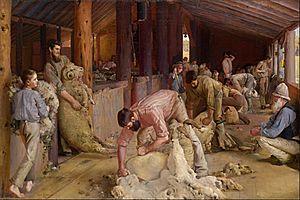
The rapid economic expansion which followed the gold rushes produced a period of prosperity which lasted forty years, culminating in the great Land Boom of the 1880s. Melbourne, in particular, grew rapidly, and briefly became Australia's largest city and for a while the second-largest city in the British Empire, before being overtaken by a population boom in Sydney in the early 1900s: the grand Victorian buildings of both cities are a lasting reminder of the period. The traditional craft of Stonemasons in Melbourne were the first organised workers in the Australian labour movement and in the world to win an eight-hour day in 1856.
Melbourne Trades Hall was opened in 1859 with Trades and Labour Councils and Trades Halls opening in all cities and most regional towns in the following forty years. During the 1880s trade unions developed among shearers, miners, and stevedores (wharf workers), but soon spread to cover almost all blue-collar jobs. Shortages of labour led to high wages for a prosperous skilled working class, whose unions demanded and got an eight-hour day and other benefits unheard of in Europe.
Australia gained a reputation as "the working man's paradise." Some employers tried to undercut the unions by importing Chinese labour. This produced a reaction which led to all the colonies restricting Chinese and other Asian immigration. This was the foundation of the White Australia Policy. The "Australian compact", based around centralised industrial arbitration, a degree of government assistance particularly for primary industries, and White Australia, was to continue for many years before gradually dissolving in the second half of the 20th century.
The Great Boom could not last forever, and in 1891 it gave way to the Great Crash, a decade-long depression which created high unemployment, and ruined many businesses, and the employers responded by driving down wages. The unions responded with a series of strikes, particularly the bitter and prolonged 1890 Australian maritime dispute and the 1891 and 1894 shearers' strikes. The colonial ministries, made up for the most part of liberals whom the unions had long seen as allies, turned sharply against the workers and there were a series of bloody confrontations, particularly in the pastoral areas of Queensland. The unions reacted to these defeats and what they saw as betrayals by liberal politicians by forming their own political parties within their respective colonies, the forerunners of the Australian Labor Party. These parties achieved rapid success: in 1899 Queensland saw the world's first Labor Party parliamentary government, the Dawson Government, which held office for six days.
The industrial struggles of the 1890s produced a new strain of Australian radicalism and nationalism, exemplified in the Sydney-based magazine The Bulletin, under its legendary editor J. F. Archibald. Writers such as A B "Banjo" Paterson, Henry Lawson and (a little later) Vance and Nettie Palmer and Mary Gilmour promoted socialism, republicanism and Australian independence. This newfound Australian consciousness also gave birth to a profound racism, against Chinese, Japanese and Indian immigrants. Attitudes towards indigenous Australians during the period varied from the outright armed hostility seen in earlier times to a paternalistic "smoothing the pillow" policy, designed to "civilise" the last remnants of what was considered a dying race.
Images for kids
-
South Australian suffragist Catherine Helen Spence (1825–1910). In 1895 women in South Australia were among the first in the world to attain the vote and were the first to be able to stand for parliament.
-
Sir Henry Parkes (1815–1896), the 'Father of Federation'
-
The commemoration of the Federation of Australia at the Sydney Town Hall in 1900
-
Cricket being played at the Melbourne Cricket Ground in the 1860s
-
The Australian Native, by Tom Roberts, 1888. The origins of distinctly Australian painting is often associated with the Heidelberg School of the 1880s–90s.
-
Writer Henry Lawson (right) with J. F. Archibald, the co-founder of The Bulletin
-
Saint Mary MacKillop (1842–1909)



